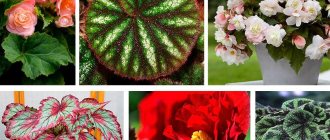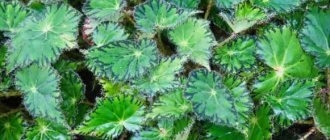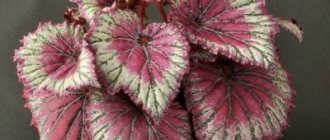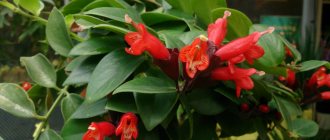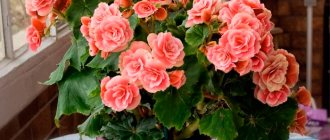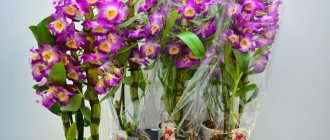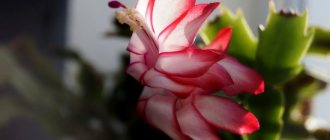A plant such as begonia belongs to the most famous and numerous genus of the begonia family. This genus unites approximately 1 thousand species of various plants, which in natural conditions can be found in the mountains, and they prefer to grow at an altitude of 3–4 thousand meters above sea level; they are also common in tropical rainforests and subtropics. These plants are also found in the mountains of India, the Malay Archipelago, the Himalayas, Sri Lanka and western Africa. There is an opinion that begonia comes from Africa, and then this plant came to America and Asia. Today, more than 1/3 of all species of this plant grow in Africa.
In the 17th century, the monk Charles Plumier found begonia and wrote a description of it. This happened during an expedition to the Antilles, the purpose of which was to collect plants. He discovered 6 different species of such a plant, which he named in honor of M. Begon, who was the governor of Fr. Haiti, with whom the monk was friends. Today, this plant is very popular and is cultivated both indoors and in the garden. Below we will talk about indoor begonia and how to plant it correctly, how to care for it, how it can be propagated and a lot of other interesting and useful information.
Brief description of the plant
Begonia can be different; there are varieties of herbaceous plants that do not exceed three centimeters, as well as shrubs with rather high branches.
Some begonia species have no stem or only one leaf. The foliage of the plant is green, the reverse side is covered with a single color or with spots and patterns.
It blooms with bright flowers in different warm shades. The flowers resemble rose petals or carnations in appearance. Flowering occurs at the beginning of summer and continues until autumn. Indoor begonia blooms longer than plants growing outside. The home flowerpot blooms from May to late autumn.
FAQ:
Why doesn't begonia bloom?
Perhaps your begonia does not have enough light, the humidity in the room is low, the temperature is inappropriate, it is located in a draft, or you simply overdo it with fertilizers. Try to change something in its usual life: move it to another window, or to a room where the temperature is different from the one where your begonia now stands. If, despite all your efforts, the begonia withers, root a few roots. She may be planning to say goodbye to you.
Why do begonia buds fall off immediately after they appear?
There can be a huge number of reasons for this. The culprit may be improper watering or even location relative to the light. It is possible that begonia does not have enough minerals, so it needs to be fed.
Why do begonia leaves turn yellow?
It is possible that begonia leaves begin to turn yellow due to lack of moisture or depletion of soil. It is possible that there are pests in the soil that affect the root system of the begonia. Therefore, we advise you to replace the soil by first clearing the roots of sand and rinsing them in water with potassium permanganate.
Begonia varieties
According to their decorative properties, all types of begonias are divided into deciduous and flowering. Deciduous varieties are valued because they have beautiful colors and interesting foliage shapes. They bloom with small flowers, which are most often torn off.
Flowering begonias have petals of different shades, shapes and sizes.
According to the structure of the rhizomes, begonias are:
- tuberous, which shed their upper part in the winter and hibernate;
- rhizomatous, which form a good powerful root system. The shoots do not die off during the winter, but the plant needs rest;
- plants whose root system grows superficially. In ever-flowering flowerpots, rhizomes develop quickly.
At home, flower growers grow royal, ampelous or elatior.
Royal begonias have large, patchy dark green, brown or red leaves. An ornamental deciduous plant can have leaves in the shape of a heart or a snail's spiral.
In ampelous begonia, the shoots hang down and bloom with white, yellow and other shades of flowers. Flowering occurs throughout the entire growth period.
Begonia elatior is grown only at home. It has thin red shoots that must be tied to a support. This variety blooms in autumn and blooms during the winter. Blooms in white, yellow, red, orange shades. The plant has glossy rounded leaves, 5 centimeters in diameter.
Main types and varieties of begonia with photos
There is currently no single classification of begonias. However, in the specialized literature one can find conventional options for dividing the species of a given plant, for example: into decorative flowering and decorative deciduous; also divided according to the type of parts of the plant located underground into tuberous, rhizomatous and with a superficial root system; There are those who divide these species into the following groups - bushy, decorative deciduous and tuberous. However, today experts are increasingly resorting to the following classification:
- bushy with erect bamboo-like stems;
- with flexible and thin drooping or creeping stems;
- with rhizomatous rather thick lying or lodging stems;
- species that are the ancestors of flowering hybrid begonias.
However, for home floriculture, the following classification is more convenient:
- decorative flowering indoor plants;
- decorative foliage indoor plants;
- decorative flowering potted plants.
Below will be presented the names of the species of such plants that are most popular in home floriculture, with their descriptions, as well as common varieties.
Leafy (deciduous) begonia
Royal begonia (Begonia rex)
The birthplace of this flower is Eastern India. It is considered one of the most beautiful. Breeders have used this species to create many decorative deciduous varieties, as well as hybrid forms. The plant has a rhizome that is thickened, and its spectacular large leaf plates are bare or with slight pubescence, reaching 20 centimeters in width and 30 centimeters in length. Their heart-shaped shape is asymmetrical, their edges are unevenly jagged or wavy. The color of the leaves can be brown-bronze, raspberry-velvety or violet-red; sometimes specks of silver or violet-red color can be seen on their surface. There are hybrid forms, the leaf blades of which are almost black, and there are crimson spots on their surface. During flowering, pink flowers appear, which are of no particular decorative value.
Popular varieties:
- Cartagena - oval leaf plates that are wrapped in a shell, painted dark green. The central part of the leaf is dark brown, but with age it changes its color to plum. On the green part of the leaf plate there are specks of silver color with a light pink glow.
- Silver Greenheart - silvery leaf blades have an oblique heart-shaped shape, they also have a green-emerald border with small silver dots.
- Chocolate Cream - the sheet plate is spiral-twisted and its central part is painted in a rich plum color. The rest of the leaf is silver in color with a pinkish tint.
- Evening Glow - the leaf blades are of medium size, and their central part is painted a rich crimson color. Brownish-green veins radiate from the center along part of the crimson-colored leaf. The leaves have a crimson edge.
- Hallelujah - has large leaves that spiral at the petioles. They are painted light purple with a silver tint. The central part and edge of the leaves are cherry in color, while between them there is a fairly wide strip of rich green color, on the surface of which there is a huge number of small silvery spots.
In addition to the varieties mentioned above, flower growers grow others. For example, the following varieties and hybrid forms are very popular: Pearl de Paris, Regal Minuet, Silver Corkscrew, Black Fang, November Frost, Lilian, Red Tengo, Titica, Benitochiba, Deudrop, Charm, etc.
Tiger begonia (Begonia bowerae), or Bauer's begonia, or maple-leaved begonia
This plant is native to Mexico. The bush is low (no more than 25 centimeters), has creeping shoots and leaf plates of a pale green color, on the edge of which there are brown or black spots. There is pubescence on the underside of the leaves. Unremarkable pale pink flowers are part of loose, drooping inflorescences. This species is rarely seen in the wild. Thanks to specialists, a large number of very beautiful varieties have appeared.
The most popular are:
- Tiger - creeping shoots can have a height of no more than 10 centimeters. There is a bronze pattern on the surface of the velvety leaves; a brown stripe runs along the veins. There are spots on the surface of the light red petioles.
- Cleopatra - on the surface of these leaf plates there are light-colored hairs, and they are able to change their color when the lighting changes. The reverse side of the leaves is burgundy or red.
Coral begonia (Begonia corallina)
This begonia is a semi-shrub, and its homeland is the tropical forests of Brazil. At home, the plant can grow up to 100 centimeters in height. It has bamboo-like, erect and bare shoots. The oblong, egg-shaped leaf blades have a jagged edge. They can reach 20 centimeters in length and 7 centimeters in width. On the surface of the dark green front side of the leaves there are small spots of silver color, while the underside is pale green. Peduncles have a coral color. They bear flowers, which are part of the inflorescences in the form of a brush. Popular varieties:
- Alfalfa - large green leaf blades have a jagged edge, there are silver spots on the front side, and a red color on the back side.
- President Carnot - the shield-shaped leaf plates at the base are dissected, and their edges are slightly toothed. The leaves reach 30 centimeters in length and 15 centimeters in width. They are colored green and have whitish spots on the surface.
Caroline begonia (Begonia carolineifolia)
This begonia is one of the oldest domestic flowers. Her homeland is Mexico. The thickness of the creeping shoot is about 4 centimeters. Large palmately dissected leaf plates are placed on greenish-yellow petioles. The leaves do not exceed 35 centimeters in length and have clearly visible veining. The pinkish-green flowers are part of loose, brush-shaped inflorescences. Flowering begins in February.
In addition to these species, the following are popular among gardeners: striped, metallic, Bovera, yellow, shiny, Mason, hogweed, white-spotted, red-leaved, Limminga, imperial, etc.
Decorative flowering begonia
Begonia semperflorens
The height of the compact bush-like bush does not exceed 60 centimeters. A young plant has erect stems, but over time they take on an ampelous or semi-ampeloid shape. The rounded leaf plates have slight pubescence along the edge, and they reach a length of 6 centimeters. They can be colored dark or pale green, and can also have a reddish tint. Small (diameter about 25 mm) flowers, double or single, can be painted pink, white or red. They are part of inflorescences, which are short-lived. Opened flowers do not delight with their beauty for long and soon fade, but they are very quickly replaced by new ones. With proper care, good lighting and regular feeding, this begonia can bloom in winter. Popular varieties:
- Gustav in Knaak - the height of a spreading bush can reach about 30 centimeters. Green leaf blades have a red border. The diameter of carmine flowers is about 3 centimeters, and they are part of the inflorescences.
- Carmen - a medium-sized bush has brown leaf blades with anthocyanin. There are also many pink flowers.
- Ambergris - the height of the bush does not exceed 15 centimeters, the leaf blades are brown, and the diameter of the pink flowers is no more than 3 centimeters.
- Bicola - the height of the bush reaches 14 centimeters. The leaves are green and the white flowers have a light pink border.
- Orania is a small bush, the height of which is about 16 centimeters. Green leaf blades have a red border. The flowers are reddish-orange.
And flower growers also prefer to grow such varieties of this species as: Bella, Rozanova, Linda, Othello, Teicher, Leila, Lucifer, Scarletta, Albert Martin, Ball Red, Kate Teicher, etc.
Begonia x elatior
This hybrid form is considered the most spectacular and has the most abundant flowering. Among domestic begonias, this plant is a favorite. The height of the bush does not exceed 40 centimeters. The shoots are thick, fleshy, the shape of the alternately arranged leaf plates is heart-shaped. The leaflets are about 8 centimeters long, and their edges are jagged. The front side of the leaves is shiny, rich green, and the back side is matte and light green. The flowers are part of the inflorescences and have long peduncles. Popular varieties:
- Schwabenland - on a tall, profusely flowering bush there are many small, rich red flowers.
- Renaissance - on a tall bush there are double flowers, the red petals of which are corrugated.
- Louise - the flowers are pale cream in color, with a light pink tint.
- Piccora - on a low bush there are deep pink flowers, which are double.
- Rose - double flowers have a dark pink color.
Also popular among flower growers are varieties such as: Kyoto, Goldfinger, Azotus, Berlin, Sharlach, Cleo, Annebel, Bellona, etc.
Begonia x tuberhybrida pendula
Often this species is grown as a garden flower or used to decorate balconies and terraces. Such a flower has drooping stems that cascade down, and there are a large number of flowers on them. To grow such plants, baskets, flowerpots or pots are used. The flowers can be densely double, double, semi-double, or single, and they are painted in red, yellow, white, pink, orange, and also in various combinations of these color shades. Flowers can be large, medium and small. Popular varieties:
- Gale - the spreading bush has hanging long (about 30 centimeters) stems, in the upper part of which there are pointed green leaf plates with a jagged edge. Light pink semi-double flowers can reach 3 centimeters in diameter.
- Christie is a spreading bush consisting of rather fragile hanging stems that do not exceed 40 centimeters in length. The diameter of the double flowers is 4 centimeters, and they are painted white.
- Roxana is a small bush consisting of hanging stems, the length of which does not exceed 40 centimeters. Four-centimeter diameter double flowers are painted orange.
- Kati is a spreading bush consisting of relatively fragile stems, the length of which is about 30 centimeters. The diameter of the yellow semi-double flowers is 3.5 centimeters.
The most popular hybrid varieties of decorative flowering begonias
- Harlequin - the height of a spreading bush is up to 25 centimeters, the leaf blades are green, and the large (diameter 12 centimeters) double flowers are yellow and have red edges.
- Gold Dress - the height of a semi-spreading bush is about 25 centimeters. The leaf blades are pale green. The densely double pink flowers are quite large (20 centimeters in diameter) and yellow in color.
- Duck Red - a spreading bush reaches no more than 16 centimeters in height. The leaves are rich green, and the peony-shaped double flowers are dark red. The diameter of the flowers is about 10 centimeters, while the petals are quite wide.
- Camellia Flora is a small bush with a height of about 25 centimeters. The leaf blades are green. Large (diameter about 12 centimeters) camelid flowers are pink, and their petals, which have whitish edges, are imbricated.
- Crispa Marginata - bush height is about 15 centimeters. The folded leaf plates are colored green and have thin purple ropes. Large (diameter about 12 centimeters) wide-oval flowers are painted white and have a rich red border. The side petals are wavy and strongly corrugated.
- Ami Jean Bard - bush height no more than 12 centimeters. Green leaf blades are small in size. The inflorescence consists of 5 small (diameter about 3 centimeters) double flowers with an orange color.
- Diana Vinyard - the height of a small bush is about 20 centimeters. The leaves are pale green. Large (diameter about 20 centimeters) densely double flowers are white in color, as well as wavy folded petals.
- Marmorata - the height of a semi-spreading bush is about 20 centimeters. The large double flowers (about 12 centimeters in diameter) are painted in a scarlet color, and there are whitish streaks on their surface.
- Fireflamme - the height of the bush does not exceed 20 centimeters. The leaf blades are green and the veins are crimson. Small (diameter about 3 centimeters) semi-double flowers have a pinkish-orange color.
Features of plant care
In order for begonia to bloom profusely and for a long time, it is important to create the right growing conditions. With timely watering and feeding, a plant at home can delight the eye with flowering almost throughout the year. In addition, it needs protection from pests. If you neglect the rules of caring for a flower, it may suffer from rot or another dangerous disease.
Lighting Features
Blooming begonia loves bright light. Therefore, it must be grown on windowsills with good lighting. In summer, it is recommended to shade the plant from direct sunlight. Since the sun can burn the beautiful leaves and flowers of the flowerpot.
Decorative deciduous begonia varieties grow and bloom best in diffused light. Therefore, they are grown on windowsills on the east or west side.
Pests and diseases
Diseases
Most often, begonias suffer from powdery mildew and gray rot .
Powdery mildew is a fungal disease. Appears as a white coating on the leaves. Reduces the decorative value of the plant and can spread to all above-ground parts. The leaves begin to turn brown and dry out. Control measures - treatment with fungicides. In the room you need to reduce the air humidity and ventilate it more often.
Gray mold appears in damp and cool conditions. Fungi attack leaves, shoots, and flowers. A gray fluffy coating forms on them. Systemic fungicides will help cope with the disease. In addition, reduce watering and ventilate the room.
Pests
Aphids are small wingless sucking insects of green or yellowish color. The pests are very prolific, multiplying quickly and sucking the juice out of the plant. The leaves turn yellow, the flowers fall off. They destroy pests by spraying plants with soap solution, tobacco infusion, and chemicals.
Spider mites , like aphids, are sucking small insects. It depletes the plants, begonia leaves become deformed, and the buds fall off. Affected bushes are washed with soapy water and treated with insecticides.
The root-knot nematode is a microscopic worm that settles on the roots and lower on the stems. Growths form on them in which larvae develop. Plants are stunted and rot. Sick plants are destroyed.
Blooming begonias will decorate your home; plants with colorful leaves of unusual shapes will enliven any interior. Looking at begonias, one cannot help but believe that “beauty will save the world.”
How to properly care for begonias? You will also learn interesting tips from experienced flower growers by watching the video.
Flower propagation methods
Begonia is propagated using leaf cuttings, stems, and dividing bushes. But in order for the plant to take root and bloom successfully in the allotted time, it is important to take into account its type and variety. Since some flowers are propagated only by dividing the bush, and some only by cuttings from leaves. To propagate a tuberous begonia variety, you need to purchase seeds or have tubers.
Propagation by cuttings
In spring or summer, begonia can be propagated using the cutting procedure:
- From a healthy plant, cut a cutting 7 centimeters long.
- Plant the cut stem in sand mixed with peat in a 3:1 ratio.
- Place the container with the planting in a dark place.
- After a couple of months, the plant will take root and begin to grow successfully.
To propagate begonia from leaf cuttings, choose a healthy, vigorous plant. Dig the cutting into the soil so that the leaf does not touch the top layer of soil. Until the leaf takes root, it is recommended to keep the container with it in a dark room.
Propagation by seeds
Begonia propagates by seeds from December to early March. The seeds are sown in an even layer in leaf soil mixed with peat and sand. When sowing, each seed should be lightly pressed into the soil. In two weeks the first shoots will begin to appear.
It is important to distribute the seedlings into different containers. After some time, young, strong plants are transplanted into separate pots with properly selected soil. If begonias are healthy and growing successfully, you can see them blooming already in mid-summer. Before winter, the plant tuber will be fully formed. In autumn, the tubers are buried in sand or peat for winter storage. Store at a temperature no higher than 10 degrees Celsius. In spring, the tubers are replanted in pots with updated soil.
Propagation by tubers
The procedure for propagating begonias by tubers:
- In the fall, carefully remove the tubers from the soil.
- Trim the foliage.
- Clean the roots well from the soil.
- Carefully separate the tuber into pieces.
- Place the finished tuber particles in peat so that they do not dry out.
- After some time, transplant the tubers into pots with sandy soil and water them moderately.
It will take a long time for a tuberous begonia to germinate. The beginning of the germination process will be indicated by the emerging shoots and roots.
Landing
After the young seedlings reach the required maturity (from 2 to 4 full-blown leaves), they must be transplanted into a pot in a permanent place.
For rooting by cuttings, loose substrates made of sand and peat are used. For permanent residence, they take a different soil: two parts of turf soil, one part of leaf soil, and one part each of sand and humus. There is another option - soil from a greenhouse, peat, rotted manure, sand - all in equal quantities. Soil for begonias can be bought at the store. Some gardeners recommend adding a little charcoal to any of these soil mixtures.
A pot for begonias is chosen taking into account the characteristics of the root system. Most plants of this family have shallow roots, sometimes superficial. So you need to choose a shallow container so that it quickly dries out any remaining moisture.
Before planting, all tools, pots and soil are disinfected - they are poured with boiling water, the soil can be calcined in the oven or on the stove.
When transplanting, the root collar (lower point of growth) is not buried.
Problems during cultivation
It often happens that begonia does not want to bloom. This problem occurs when:
- insufficient lighting;
- improperly selected soil;
- improper transplantation;
- not timely fertilization;
- absence of a rest period;
- too dry air;
- pest damage;
- severe drying of the soil or watering with hard water.
In order for begonia to start blooming again, it is necessary to change the growing conditions.
Sometimes a begonia cannot bloom due to age or an incorrectly planted plant. If the shrub does not bloom, it may be a variety with decorative leaves. Decorative deciduous begonias have beautiful leaves of large or small sizes, with an exquisite shape and pattern. Often the stems of such plants are creeping, and the foliage rises high on elongated cuttings. Decorative deciduous begonias do not bloom, but there are varieties of this species that bloom very few small flowers.
How to care after the begonia has bloomed
The flowering period ends with the onset of the first cold weather. Withered buds, dry leaves, and shoots directed inward are removed. This allows you to rejuvenate the plant. Plants should be trimmed with a clean, sharp knife, and the cut areas should be sprinkled with activated carbon or wood ash.
You can admire the flowering of begonia for a long time, but for the beauty of the plant it needs a little help by providing the right growing conditions. Maiden's beauty, as begonia is also called, is unpretentious, but ignorance of some nuances can negatively affect the growth and number of flowers.
Features of growing begonia in open ground
If you decide to grow begonia in a flowerbed, be sure to keep in mind that it does not tolerate frost. Therefore, it is recommended to plant in open ground or take pots out into the fresh air in April or May. It is recommended to grow the flower in a flower bed well lit by the sun. But you should protect it from drought. If the plant is planted in shade or partial shade, it will develop slowly and not bloom very profusely.
Begonia grown in open ground blooms from June to September. If you have time to transplant the plant into a pot before the onset of frost and bring it into a warm room, it will continue to bloom for another two to three months. You need to water the outdoor flower when the top layer of soil becomes dry.
To decorate flower beds and borders, flower growers plant Illumination, Nonstop, Chanson. The Illumination variety is planted in balcony boxes and flowerpots, as it has weeping stems. The Nonstop variety has erect stems reaching a height of 20 centimeters. It blooms with large yellow flowers. The hanging variety Chanson has beautiful cascading double flowers reaching 6 centimeters in diameter.
Now you know when begonia blooms, how it is grown, and also how long it can bloom. In order for the plant to bloom abundantly and for a long time, it is important to provide it with all comfortable conditions. Replant, water, feed in a timely manner. Propagate if necessary. Begonia should also be protected from pests and diseases. Since they can lead to the fact that the flower stops blooming and may even die.
PLUM2GThe history of the flower
Begonia is a wonderful plant that can be planted not only in a pot, but also in a garden, park, flowerbed, or near the border. The Begoniaceae family, to which it belongs, is huge. Breeders counted 900 full-fledged and 2000 hybrid species. The flower was first described in 1690 by Michel Begon. The name came from his last name. The plant began to be used as an ornamental crop only 200 years ago.
The history of begonia leads to the Antilles, where it was described by the discoverer Begon. A few years later they found Brazilian begonia. Then a royal view was discovered on the island of Hindustan. And in South America, a tuberous subspecies was bred. All modern varieties originated from them. The flower began to be widely used for decorative purposes and gained incredible popularity. At first it was grown only in greenhouses, and then adapted to home conditions.
To date, a large number of hybrids and varieties of cultivated begonia have been bred. According to their decorative qualities, all types are divided into two groups:
- blooming;
- decorative deciduous.
Recently, the tuberous appearance has gained popularity. It has incredibly bright flowers.
In nature, begonias grow in the tropics and subtropics. They love shade, moisture, steep shores near the sea and dry slopes in the mountains.
Awakening
- At the end of February, tuberous begonia is prepared for new flowering: the tubers are inspected and placed in a warm, bright place. After the sprouts appear, the rhizomes are placed in a pot.
- Begonias of non-tuberous varieties are simply transferred to a bright, warm room and watered intensively. When the plant finally wakes up and begins to grow, it is fertilized. Apply liquid mineral fertilizers to flowering plants.
Begonia needs care not only before budding. The end of flowering is the next stage in the plant care cycle. How a culture finishes the current year determines its condition in the next one. Begonias must be cared for year-round, taking into account the characteristics of different periods.
Home care after flowering
- After removing dried flowers, begonia needs pruning.
Cut the stem, leaving 5 centimeters. This is necessary for the culture to gain strength and receive nutrients. Begonias are trimmed with a sharp knife (how to prune begonias correctly?). Do not use garden shears to avoid damaging the plant. - In order to prevent rotting and speed up the healing process, the cut areas are treated with wood ash.
- After pruning, watering is reduced from the end of October.
- If the shoots have reached 12 cm, they are stopped.
- After the leaves turn yellow, moisturizing is stopped until spring. The container with the plant is placed in a shaded place with a temperature of + 15-17 degrees.
Difficulties may arise when caring for begonias, so we recommend that you familiarize yourself with the following materials:
- Why do the leaves curl and how to save the flower?
- Why do begonia buds fall off?
- Features of begonia transplantation. Caring for the plant after the procedure.
What to do next with the plant?
What to do with the plant depends on the type of root system (you can learn about the types of begonia and its root systems here).
Tuberous
If the begonia is tuberous, the roots are dug up to save them until next year. Rules:
- When the above-ground part is dry, the tubers are pulled out of the pot.
- Remove all dried roots.
- Inspect for rotting. If there are rotten roots, they are carefully trimmed with a sharp knife. Sprinkle with charcoal powder and dry.
For storage, the tubers are placed in an airtight container, lightly sprinkled with sawdust or damp sand. Planting material is kept in a cold place until spring.
Watch a video about what to do with tuberous begonia during the dormant period:
Not tuberous
In begonias with a regular root system, the flowering period lasts until spring. It is recommended to give plants rest.
Note! As soon as flowering begins to decline, the conditions for keeping the crop are changed from November-December.
To do this, take the following actions:
- Stop feeding.
- Reduce watering. The soil is moistened when it becomes completely dry.
- Trim the plant. Unnecessary shoots are removed, the main ones are trimmed, leaving 12-15 cm. The cut areas are treated with coal powder.
Begonias need to be provided with a normal level of humidity. You can spray the air around the plant or install a tray with water. Pebbles are poured into the bottom of the container and a pot is placed on top.
The flower is taken to a dark place. Bright light promotes resumption of flowering, and buds are formed during short daylight hours. The temperature during this period is reduced to + 10-15 degrees.
From the video you will learn what to do if the non-tuberous begonia has faded:
